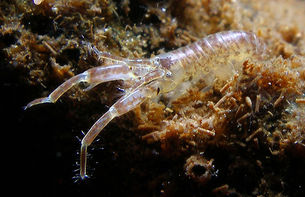Chelicorophium curvispinum
The freshwater tube cancer ( Chelicorophium curvispinum ) is a common in fresh and brackish water Flohkrebsart. Originally native to the Black Sea and its tributaries, he is now spread over most of Europe and is among the most common invasive species in central European rivers.
Features
Chelicorophium curvispinum reaches a body length of 9 mm. He is white or yellowish with a faint dark spots and tying drawing. The dark-colored compound eyes are relatively small.
Types of Corophiidae family are from other amphipods on the little side, but rather dorsoventrally flattened body shape (similar to a woodlouse ), the small Coxalplatten at the base of the legs and especially the greatly enlarged second antennae distinct, which are always stronger than all than the rest of the body can be pairs of legs and longer. Chelicorophium curvispinum is one of the few living in freshwater species of this predominantly marine group. The distinction from other living in fresh or brackish water forms is difficult and only possible under the microscope. From Chelicorophium robustum, with whom he frequently occurs in common (eg the Rhine ), it differs by the formation of some small denticles on the last link of the antenna base ( peduncle ) (see ).
The life and habitat
Chelicorophium curvispinum reaches three generations per year, it multiplies in central Europe from April to October. Newly hatched individuals multiply, depending on the season, in the same year or after a winter; they die in this case the following summer. In natural populations, a moderate is observed up to large excess of females.
The amphipod builds burrows by filtering out particles from the water and bonded with secretion. He usually leaves these tubes not voluntary. It feeds as filter feeders, scrapes subordinate and he scratches material within its tube from the surface. Filter bodies are the maxillipeds and the first two Peraeopodenpaare ( Gnathopoden ), which are covered with long bristles filter, and he draws in rapid movement through the water (active filter feeders ). As a base for the burrows serve him hard substrates of all kinds, such as Stones, wood, aquatic plants. It can also be the surface of other sessile animals such as Shells and sponges cover. On soft substrates such as sand or silt he can not live, he does not have a grave assets.
In suitable habitats, the amphipod reach enormous densities. He reached up to 18,700 individuals per square meter in the same and even incredible 75,000 individuals per square meter in the Lower Rhine. At these high densities of the amphipod can change its habitat massive. It can cover all stone surfaces with a dense layer of mud and thus displace other Hartsubstratbesiedler from the living space through the densely packed tubes and the accumulated fine material. He has ( also neozoische ) zebra mussel ( Dreissena polymorpha ) displaced from parts of the Rhine. For some years there is evidence of a population decline, which is attributed to predation by the neozoischen also, later entrained Great Dikerogammarus
Chelicorophium curvispinum preferred flowing waters ( rheophil ). It is less common in stagnant waters before, as far as having these hard substrate base, eg on stone wraps in the lakes IJsselmeer in the Netherlands. In running waters it is found almost exclusively in larger rivers ( potamal ). In streams its high temperature needs are not usually met. He also meets regularly and in high density prior to shipping canals. The way most populated shore areas and does not penetrate far into deep water layers.
He comes in fresh water, rarely in brackish water before, eg in the Elbe estuary and the Baltic Sea. Here it is but usually replaced by other types of Corophiidae. In the brackish water colonization him his osmoregulation flexible benefits. This is probably due to the fact that the species has penetrated into fresh water until comparatively recently.
Chelicorophium curvispinum preferably organic moderately to highly polluted waters. His saprobic index is 2.2.
Dissemination and Immigration
The species originates from the area around the Black Sea, he lives in the leading- here rivers Don, Dnieper, Dniester and Danube (up to the Iron Gate ). A first wave of immigration, there were over the Dnieper, Pripyat, Bug, the Vistula and the Warta first occurrence in Germany: 1912 Müggelsee in Berlin. The further spread occurred on North German channels, starting in 1987, the cancer is in the Rhine to find. A second wave of immigration came over the Danube. The commissioning of the Main- Danube Canal, the two populations mixed. The way spreads active, but spread mainly by ships on whose shells he can build tubes. With transport by ship, he was, for example, to England introduced ( first record: 1935 in Avon).
The way spreads out further. So it has reached Ireland until 2000
System
Pending revision of Corophioidea by Bousfeld and Houwer 1997, the manner of a broad genus Corophium was allocated and accordingly called Corophium curvispinum; under this name it is mentioned in many previous articles. The first found in Central Europe Animals ( 1912 Müggelsee in Berlin) were described by their discoverer, D. Wundsch under the ( synonymous ) names Corophium Devium mistake a second time, some agent, especially in England, then called the freshwater form Corophium curvispinum var Devium.
In the middle and lower Danube, but ( so far? ) Not in Central Europe, lives a related and very similar way Chelicorophium sowinskyi. This has been very similar (possibly synonymous by some agents ) and so far little distinction to curvispinum.










